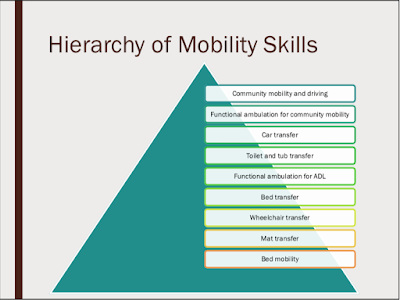Restoring Confidence!

Hey bloggers! Today I will be talking about functional and community mobility, in relation to the hierarchy for restoring bed mobility skills in clients as OTs. The hierarchy for restoring bed mobility skills (least to greatest confidence) is: bed mobility, mat transfer, wheelchair transfer, bed transfer, functional ambulation for ADL, toilet and tub transfer, car transfer, functional ambulation for community mobility, and community mobility and driving. The hierarchy of skill building for bed mobility is based on increasing activity demands of each task and illustrates the sequence for intervention planning. Initially, I didn't really understand the order or sequence of the skills; or why they were placed in the hierarchy like they were. As I was reading about restoring functional and community mobility, it became more clear. We discussed in class that "mobility = controlled instability". This means that a body is easier to move when the base of support (BoS) is